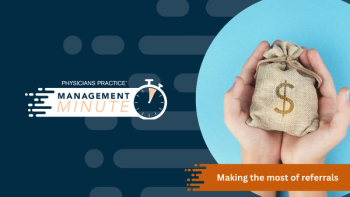
Low-Level MDM; Teaching Doc Requirements; Referral Confusion
Our coding expert discusses coding for low-level MDM; teaching physician requirements; referral confusion, and transitional care management.
LOW-LEVEL MDM
Q: When using the Medical Decision-Making Tables (MDMs) that most Medicare Administrative Contractors (MACs) and most commercial payers use, would one stable problem normally be assigned a value of minimal decision making? Would that be associated with a 99212?
A: Yes, you are correct, and you have put your finger squarely on something that is often either misunderstood or deliberately overlooked. As you seem to be aware, there are three decision-making tables - all assign point values to certain configurations of problems, either the number of problems, the status or severity of problems, or the data/diagnostics and certain information that goes along with addressing medical problems.
The Table of Risk, the third table, clearly labels low-level decision making as "one stable chronic illness." The idea is that with patient compliance these problems are minimal risk. The examples given are controlled hypertension; non-insulin dependent diabetes; and for the acutes, allergic rhinitis and simple sprains.
And low-level decision making is associated with CPT code 99213 - long the most widely reported CPT code, a code that Medicare pays billions for annually.
When you factor in Table I (or Table A), which counts the number of minimal, stable, worsening or new problems, one established single system stable or simple issue described as above scores as minimal diagnostic options. In the absence of more than one type of diagnostic, lab, image, or other medical test from Table II (or Table B), the overall scoring system for decision making brings you to minimal MDM. This does equate to 99212.
But the tables are tricky. If a patient's simple sprain results in a prescription muscle relaxant, a strict interpretation of the decision-making tables vaults the level of MDM to moderate. The tables are best used as a guide - not an absolute indicator.
Some years ago Trailblazer Health Enterprises (a Medicare Administrative Contractor) did a study that determined that over 50 percent of all E&M visits were "over-coding" low-level decision making, calling stable, single-system problems 99213s when they were technically minimal decision making in the tables.
But there are three things wrong with that:
1. The Federal Documentation Guidelines only contain the Table of Risk, which identifies one stable chronic problem as low.
2. The CPT manual, which the Federal guidelines use as part of their process, still indicates that for an established patient only two of three components must be met for history, exam, and MDM.
3. Actual medical necessity and risk dictates that managing a chronic problem is worth the weight of the one RVU originally intended for 99213, not the subacute weight of a 99212, which is for ear rechecks and wound rechecks.
If you call all these types of visits 99212s, you will be well out of step with the rest of the provider community which has developed a decent sense of the spirit of coding in this regard, if not the letter of it - not to mention the damage that you will do to your revenue stream. It's the 1987-era tables that are off base on this one.
TEACHING PHYSICIAN REQUIREMENTS
Q: I am assisting a Federally Qualified Health Center. The center has residents and meets the requirements for the Primary Care Exception rule. We are using modifier GE.
I know the residents can see patients for lower levels of service (Level 3 or below) without the teaching physician, however, can the teaching physician, who becomes the "billing provider," be off site?
A: There are very definite rules about this and the teaching physician must be on site. There are actually two levels of supervision depending on whether the resident has greater than or less than six months in the program. Here are the key provisions:
Teaching physicians submitting claims under this exception may not supervise more than four residents at any given time and must direct the care from such proximity as to constitute immediate availability. Teaching physicians may include residents with less than six months in a GME approved residency program in the mix of four residents under the teaching physician's supervision. However, the teaching physician must be physically present for the critical or key portions of services furnished by the residents with less than six months in a GME approved residency program. That is, the Primary Care Exception does not apply in the case of residents with less than six months in a GME approved residency program.
Teaching physicians submitting claims under this exception must:
• Not have other responsibilities (including the supervision of other personnel) at the time the service was provided by the resident;
• Review the care provided by the resident during or immediately after each visit. This must include a review of the patient's medical history, the resident's findings on physical examination, the patient's diagnosis, and treatment plan (i.e., record of tests and therapies); and
• Document the extent of his own participation in the review and direction of the services furnished to each patient.
For more guidance, visit
REFERRAL CONFUSION
Q: I run an endocrinology office and my staff is telling me that specialists aren't allowed to refer to other specialists if the diagnosis isn't related to the referring specialist's field of practice. For example, if an endocrinologist recommends that a new patient see a neurologist about a tremor, the endocrinologist can't make an "official" referral because the referral is not related to endocrinology. Is this a rule?
A: I have no idea where this might be coming from. It's certainly not coming from the AMA or CPT. I suppose an insurance company could have an interest in running things through a primary-care physician or "gatekeeper" in this way, but the specialist in that type of HMO environment would refer back to the primary-care provider. This may be a problem of your making. Track down the "source" of this direction.
TRANSITIONAL CARE MANAGEMENT
Q: What is the interpretation of a face-to-face visit for transition of care? Is it an office visit to set up home care or a visit in the hospital by a physician to set up home care? Does the home-care agency qualify to do the face to face? Is there a code for setting up home care without a hospital/office visit?
A: The face-to-face visit described by the transitional care management codes is intended to be in the office of the primary-care physician or provider assuming overall responsibility for the transition.
I see that your questions are directed primarily toward home care. The home-care agency would not be the intended user of these codes, but would rather be one of the entities contacted by the primary-care provider as part of the transition process. There is no code for setting up home care to my knowledge, only the delivery of it.
Bill Dacey, CPC, MBA, MHA, is principal in the Dacey Group, a consulting firm dedicated to coding, billing, documentation, and compliance concerns. Dacey is an AAPC-certified instructor and has been active in physician training for more than 20 years.
This article originally appeared in the July/August 2015 issue of Physicians Practice.
Newsletter
Optimize your practice with the Physicians Practice newsletter, offering management pearls, leadership tips, and business strategies tailored for practice administrators and physicians of any specialty.














